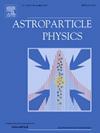Isotropization and complexity based extended Krori–Barua and Tolman IV Rastall models under the effect of electromagnetic field
IF 2.9
3区 物理与天体物理
Q1 ASTRONOMY & ASTROPHYSICS
引用次数: 0
Abstract
Three different exact solutions to the gravitational equations are formulated in this paper in the context of Rastall theory using the gravitational decoupling strategy. For doing so, the anisotropic spherical interior fluid distribution is assumed as a seed source characterized by the corresponding Lagrangian. I then modify the field equations by introducing an additional source which is gravitationally coupled with the former fluid setup. Since this approach makes the Rastall equations more complex, I use the MGD scheme to tackle this, dividing these equations into two systems. The Krori–Barua and Tolman IV spacetimes are taken into account to solve the first system, describing an initial anisotropic fluid. The metric potentials associated with these solutions contain multiple constants which are determined with the help of boundary conditions. Furthermore, I work out the solution for the second system through different well-known constraints. Afterwards, the estimated data of a compact star is considered to explore the feasibility of the developed solutions through graphical interpretation. It is concluded that all the resulting models show physically existing profiles under the variation of certain parameters.
电磁场作用下基于各向同性和复杂性的扩展Krori-Barua和Tolman IV Rastall模型
本文在拉斯托理论的背景下,利用引力解耦策略,给出了三种不同的引力方程的精确解。为此,将各向异性球形内部流体分布假设为具有相应拉格朗日特征的种子源。然后,我通过引入一个额外的源来修改场方程,该源与以前的流体设置重力耦合。由于这种方法使Rastall方程更加复杂,因此我使用MGD方案来解决这个问题,将这些方程分为两个系统。本文考虑了Krori-Barua和Tolman IV时空来求解第一个系统,描述了一个初始的各向异性流体。与这些解相关的度规势包含多个常数,这些常数由边界条件确定。此外,我通过不同的已知约束条件对第二个系统进行求解。然后,考虑了一颗紧凑型恒星LMCX−4的估计数据,通过图形解释来探索所开发解的可行性。结果表明,在一定的参数变化下,所有模型都显示出物理上存在的剖面。
本文章由计算机程序翻译,如有差异,请以英文原文为准。
求助全文
约1分钟内获得全文
求助全文
来源期刊

Astroparticle Physics
地学天文-天文与天体物理
CiteScore
8.00
自引率
2.90%
发文量
41
审稿时长
79 days
期刊介绍:
Astroparticle Physics publishes experimental and theoretical research papers in the interacting fields of Cosmic Ray Physics, Astronomy and Astrophysics, Cosmology and Particle Physics focusing on new developments in the following areas: High-energy cosmic-ray physics and astrophysics; Particle cosmology; Particle astrophysics; Related astrophysics: supernova, AGN, cosmic abundances, dark matter etc.; Gravitational waves; High-energy, VHE and UHE gamma-ray astronomy; High- and low-energy neutrino astronomy; Instrumentation and detector developments related to the above-mentioned fields.
 求助内容:
求助内容: 应助结果提醒方式:
应助结果提醒方式:


